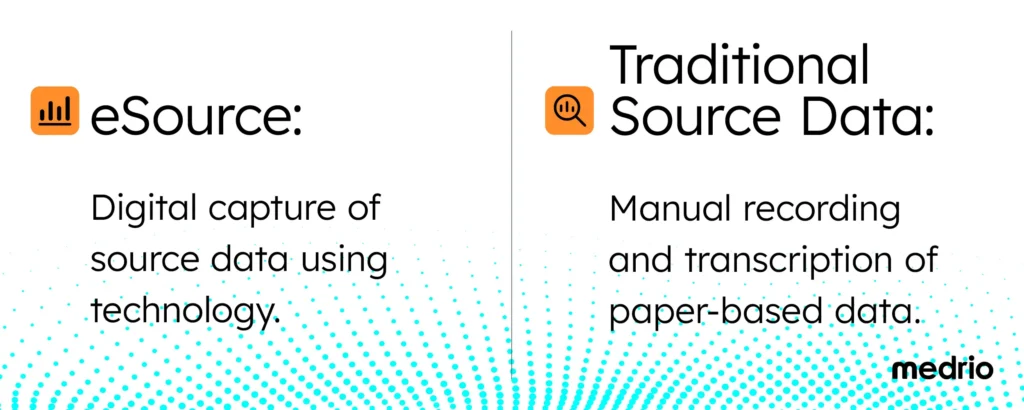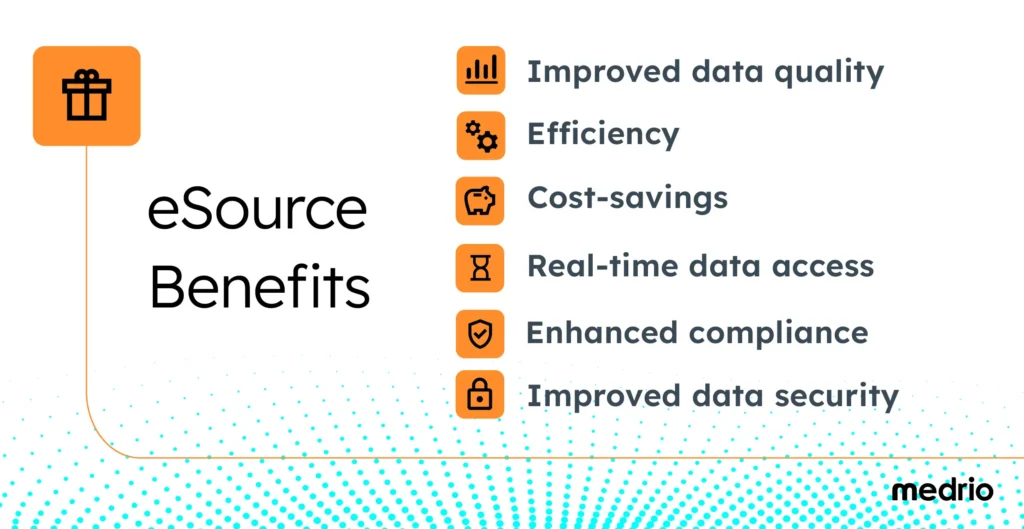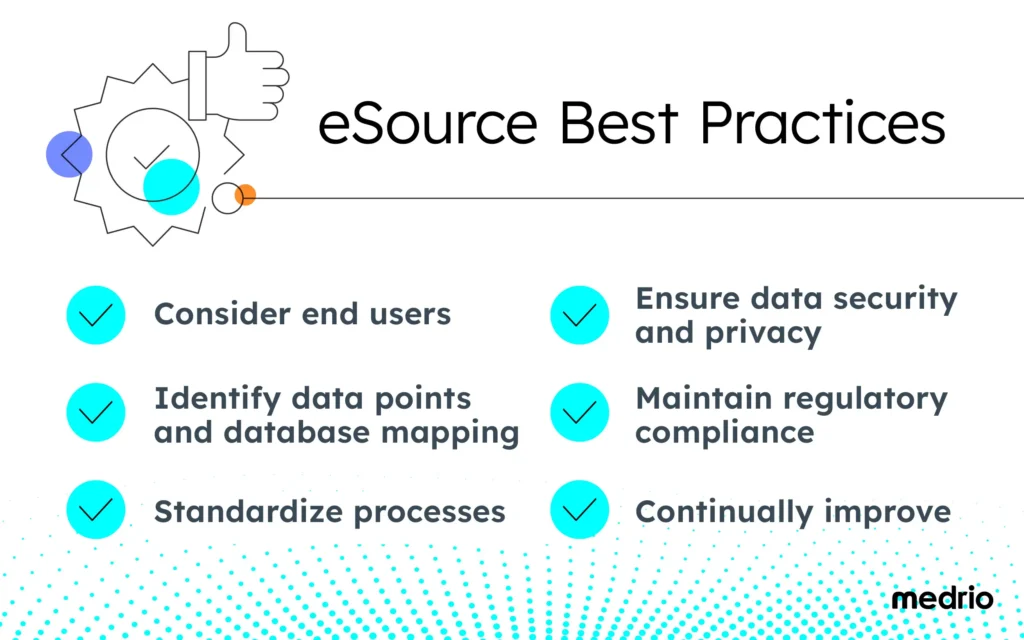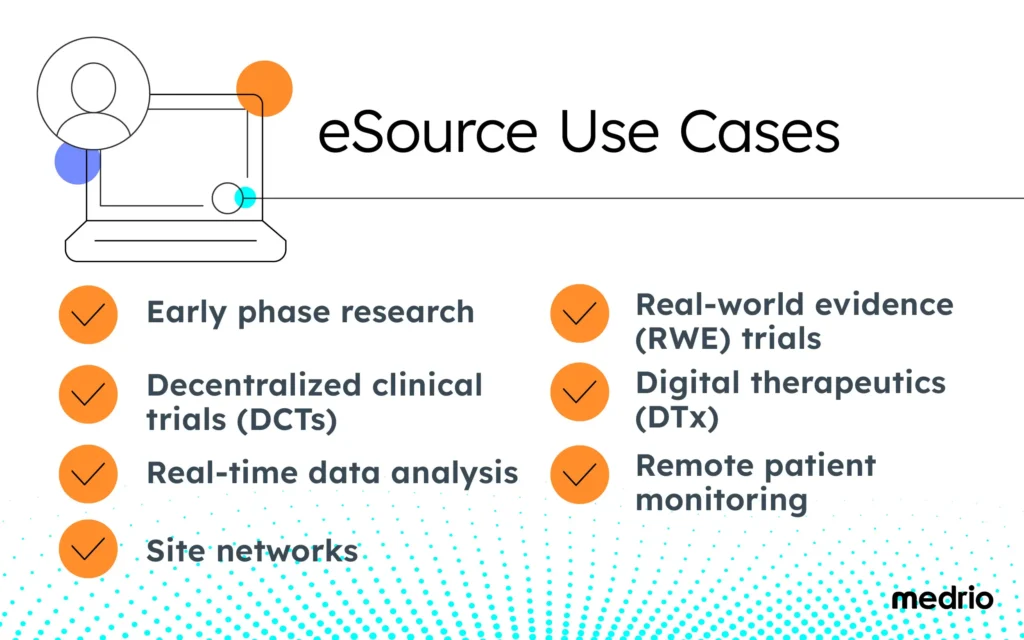Contributing experts at Medrio: Melissa Newara, VP of eClinical Solutions and Consulting, and Rod McGlashing, Data Science Subject Matter Expert
eSource, or electronic source data, is important for modern clinical trials. This data capture type supports data integrity, regulatory compliance, and better trial outcomes. It also helps with data accuracy, efficiency, and traceability.
With clinical research becoming more complex, sponsors and contract research organizations (CROs) seek solutions.
This article provides an eSource overview, key benefits, and impacts on the clinical trial process.
What Is eSource in Clinical Trials?
eSource is electronic data initially recorded in digital format during clinical investigations. The methodology used to collect electronic data is also often referred to as eSource. According to the FDA, eSource includes original records or certified copies of “clinical findings, observations, and activities” used to accurately reconstruct and evaluate the study.
eSource vs Traditional Source Data
Traditional paper-based data involves manual recording of data. Due to storage and transcription, this approach can increase the risk of errors, inefficiencies, and costs.
In contrast, eSource digitally captures source data in clinical trials. The use of electronic source data collection enhances accuracy, reduces manual workload, and lowers costs. It also streamlines regulatory compliance with traceability and real-time access for data review.
These advantages make eSource a more reliable and efficient option for modern clinical trials.

Types of eSource Solutions in Clinical Trials
eSource software solutions in clinical trials include electronic data capture (EDC) systems. They also include solutions like ePRO/eCOA, electronic health records, eConsent, wearables, sensors, and other technology.
Depending on the workflow and processes, certain labs and imaging systems qualify as eSource. Below are a few solutions that can capture eSource.
1. Electronic Data Capture (EDC) Systems
EDC may be included as part of paper source workflows. But appropriately designed EDC solutions also electronically collect and manage data, replacing paper case report forms (CRFs) and source documents. These data might include operational notations, non-research data, and clinical trial data.
Capturing source data in electronic form has many benefits. This approach enhances data integrity, reduces errors, and supports faster regulatory submissions. It can also reduce the need for source data verification (SDV). Many of these benefits are due to real-time data validation and tracking.
Read more about what an EDC is and its benefits in our EDC in clinical trials blog.
2. Electronic Clinical Outcome Assessments (eCOA) and Electronic Patient-Reported Outcomes (ePRO)
eCOA electronically captures clinical outcomes from clinicians and observers. ePRO solutions collect patient-reported data directly from participants using digital devices.
These tools streamline data collection by minimizing manual transcription errors and providing real-time monitoring. Overall, eCOA/ePRO improves data accuracy and compliance.
Learn more about how ePRO outperforms paper in our blog, “ePRO vs Paper.”
3. Electronic Health Records (EHR/EMR)
EHR/EMR systems store patient medical records digitally, offering real-time access to data.
When integrated into clinical trials, EHRs enable direct data transfer. This approach improves efficiency and ensures accurate, up-to-date clinical data.
4. Electronic Consent (eConsent)
eConsent solutions digitize the informed consent process. Advanced eConsent vendors provide participants with interactive, multimedia-rich explanations of study protocols.
These platforms improve participant understanding and enhance compliance. Importantly, eConsent also creates an auditable consent trail for regulatory purposes.
Are you interested in implementing eConsent? Learn more in our blog, “Proven eConsent Implementation and Adoption Best Practices.”
5. Wearables and Sensors
Wearables and sensors directly collect physiological and behavioral data from participants.
This data can include heart rate and activity levels. These devices facilitate continuous monitoring and generate rich datasets. Wearables and sensors can support accurate assessments of clinical outcomes.
Benefits of eSource in Clinical Trials
eSource improves data accuracy, efficiency, and compliance. Using eSource workflows improves clinical trial efficiency by eliminating transcription, reducing errors, reducing source data verification (SDV), and enhancing data accuracy.
It supports real-time data access, improves traceability, and lowers overall costs. These benefits make eSource essential for faster, more reliable trial outcomes.

Improved data quality
Since eSource directly captures data, it reduces transcription errors and improves accuracy. Often this methodology using technology, like an EDC, also supports real-time edit checks and visibility into the data source through reports. All of these features support high-quality data.
Efficiency and speed
Implementing eSource workflows may require some effort during trial setup. If done thoughtfully, it speeds up data collection and processing during the trial. With electronic data capture and fewer manual tasks, trials can proceed faster. Overall, eSource can reduce clinical trial timelines.
In this article, learn how DP Clinical leverages Medrio to accelerate study timelines.
Cost-savings
eSource reduces costs by minimizing paper use, site monitoring travel expenses, and storage costs. Additionally, reduced source data verification (SDV) effort leads to further operational savings.
Real-time data access
With eSource, stakeholders can access data in real time. This approach allows sponsors and CROs to make faster, informed decisions during the trial. Quicker access to clean data also means quicker data analysis and earlier detection of trends or issues.
Enhanced compliance
eSource solutions should support compliance with regulatory requirements such as FDA 21 CFR Part 11. Following established standards, eSource enhances audit readiness and ensures data integrity.
Improved data security
Unlike paper binders, which are vulnerable to loss or unauthorized access, eSource ensures data is securely stored and encrypted. Digital solutions reduce the risk of data exposure, enhancing overall clinical trial data protection and privacy.
Key Strategies for Implementing eSource Technology
Change is hard. Using eSource in clinical trials can boost efficiency but also comes with challenges.
From fears of change to vendor selection, this section covers how to implement eSource successfully. The right plan in action brings the most benefits.
- Change management. Team members may worry about making mistakes and creating cascading queries. Therefore, it’s crucial to highlight the benefits of eSource and offer training. For long-term success, the data capture workflow should be built with the clinical research site workflows in mind.
- Planning and preparation. A holistic approach ensures the systems align with objectives, research site capabilities, and regulatory requirements. Addressing potential challenges early on minimizes disruptions once data collection begins.
- Choosing the right technology. Prioritize ease of use, integration capabilities, and scalability. The chosen methodology should also meet the trial’s data requirements, support site workflows, and comply with regulations.
- Training and support. Practical training and support are crucial for the adoption of eSource in clinical trials. While vendors should provide technical training and ongoing support, sites and other data suppliers need to establish appropriate workflows.
To learn more, read our blog, “How eSource Optimizes The Clinical Site Experience.”
Best Practices for eSource Clinical Trials
Using eSource effectively requires more than just adopting new technology.
This section outlines best practices from leading experts to ensure a smooth transition. With these steps in mind, you are well on your way to using eSource to improve your trials.
- Consider end users. To ensure the smooth implementation of eSource, prioritize the ease of use for both sites and patients. Involve sites early in the setup process. It is important to understand how sites collect data and ensure the system aligns with their existing workflows.
- Identify data points and database mapping. Identify the key data points for the trial and accurately map them to the database. This approach ensures that data is captured correctly and aligns with the study’s objectives, improving consistency and reducing errors.
- Standardize processes. Advocate for standardized procedures to streamline data collection across sites. Update standard operating procedures (SOPs) to keep consistency across trials and reduce discrepancies.
- Ensure data security and privacy. Robust data security measures, such as role-based user permissions, prevent unauthorized individuals from accessing data. System timeouts can also protect patient data.
- Maintain regulatory compliance. The system that enables eSource must comply with applicable regulations. These regulations may include 21 CFR Part 11, GDPR, HIPAA, and ISO standards. Compliance with legal and industry requirements safeguards data integrity and patient privacy.
- Continually improve. Regularly review and update processes to keep pace with evolving technology advancements and regulatory standards. Ongoing staff training and up-to-date SOPs help maintain smooth operations throughout the trial.

Challenges in eSource Technology Implementation
Technology that supports eSource can bring big advantages. However, implementation is not without challenges. Technical issues, regulatory hurdles, and cost concerns may arise.
Understanding how to overcome these barriers is the key to a successful eSource transition in clinical trials.
- Technical barriers. Technology may face technical issues. These issues may include software glitches, connectivity problems, or integration challenges. To mitigate these risks, conduct thorough system testing and provide reliable IT support. It is also important to choose providers with strong technical capabilities and responsive vendor support.
- Regulatory hurdles. Navigating complex regulatory requirements can be daunting. Ensure compliance by selecting technology that meets industry standards. Maintain proper documentation to satisfy audits and inspections.
- Resistance to change. People may resist adopting eSource due to workflow concerns or unfamiliarity with the technology. Overcome this by clearly sharing benefits, involving teams early, and providing thorough training and support.
- Cost considerations. eSource may require an upfront financial investment in technology, training, and process changes. Manage costs with scalable solutions and factor in long-term savings, such as reduced monitoring costs.
Use Cases for eSource in Clinical Trials
eSource offers versatile options for nearly every phase of clinical trials. There are almost unlimited use cases for eSource. It enhances efficiency, accuracy, and compliance across diverse research settings.
- Early phase research. Ideal technology for early phase trials facilitates efficient data collection, monitoring, and management. eSource helps streamline operations and ensures data accuracy in small, controlled study groups.
- Decentralized clinical trials (DCTs). eSource plays a critical role in DCTs by reducing the need for on-site patient visits and increasing trial accessibility. Its support of data submission via mobile devices can improve patient recruitment and retention.
- Real-time data analysis. With eSource, data is captured and analyzed in real time. Sponsors and CROs can then make quicker, more informed decisions. Immediate data access enables faster identification of trends and potential issues.
- Site networks. With the right preparation, clinical trial data management across site networks is simpler with eSource due to standardized data collection. This approach makes it easier to consolidate and analyze information from multiple locations.
- Real-world evidence (RWE) trials. Retrospective RWE trials use existing healthcare data to identify patterns, outcomes, and trends. By integrating with databases and EHRs, eSource improves the speed and accuracy of these studies.
- Digital therapeutics (DTx). Digital therapeutics (DTx) inherently incorporate eSource components. They often involve tracking patient data through apps, wearables, or other digital tools. Ongoing monitoring and data collection are essential for personalized treatment plans and effective outcomes.
- Remote patient monitoring. eSource enables continuous, real-time monitoring of patients outside traditional clinical settings. Devices like wearables can improve patient engagement and provide more accurate, real-world data.

Need a Reliable eSource Solution? Choose Medrio!
eSource enhances clinical trials by improving data accuracy, efficiency, and compliance. From reduced monitoring to seamless EHR integration, it offers benefits across all trial phases.
Do you need a reliable solution that supports eSource? Clinical trial sponsors and CROs should explore Medrio solutions to optimize workflows, reduce errors, and achieve more reliable results.
Ready to discover the right technology for your next trial? Download our eBook “Set Up to Scale: What to Look for in a Strategic CDMS/EDC Partner.”
eSource FAQs
Explore common questions about eSource in clinical trials.
What are the initial costs of implementing eSource?
Initial costs include purchasing technology, updating SOPs, change management, mobile hardware, and internet setup. Training may require ongoing investment. Many of these expenses already exist in traditional trials. A shift in mindset and strategic technology choices can help effectively manage costs.
How does eSource impact patient recruitment and retention?
Using patient-centered technologies as part of an eSource strategy improves retention by offering convenience and better alignment with patients’ daily lives. For site-only trials, eSource has limited impact on recruitment or retention.
What are the regulatory requirements for eSource?
Depending on where the clinical trial is located, eSource must meet different regulations from agencies like the FDA and EMA. These regulations may include 21 CFR Part 11, GDPR, HIPAA, and ISO standards. Special note should be given to any digital health technology (DHT) guidance.
How do you ensure data security with eSource?
Data security is maintained through encryption, role-based access controls, system timeouts, and authentication processes. Adhering to industry standards and regulations ensures the protection of sensitive patient data.
Can you integrate eSource with existing systems?
Integration is possible if systems have API capabilities and proper consent is obtained. Identify critical data points and endpoints to avoid burdening the study team with unnecessary data from devices like wearables.
What if the internet is down? What do I use for a backup during a power outage?
In case of internet or power outages, use paper forms or an offline electronic system. Ensure a robust storage plan for transferring data once the system is back online, if needed.
When is eSource most valuable?
eSource is beneficial across the clinical trial lifecycle. It may be ideal to introduce eSource methodologies in early phase trials with fewer sites and controlled workflows. Then as trials progress into later-phases trials, eSource processes can scale with new complexities.



